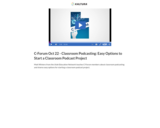Cinderella stories and graphic organizers help students with their reading, comprehension, and oral presentation skills.
- Subject:
- Elementary English Language Arts
- Material Type:
- Lesson
- Author:
- Utah Lesson Plans
- Date Added:
- 08/26/2021
Cinderella stories and graphic organizers help students with their reading, comprehension, and oral presentation skills.
The use of multicultural versions of the story Cinderella helps students make comparisons and observations.
Several version of Cinderella are read to students as they fill out comparison charts. The fairy tale genre is introduced.
2nd grade Students will be integrating social studies cultural awareness with cultural stories of Cinderella. Students will listen to the Charles Perrault version of Cinderella and identify the main characters, plot and conflict. They will read another version and identify similarities and differences of the two stories. They will create Venn diagrams to look at similarities and differences of their own school cultures and then use Venn diagrams to look at similarities and differences of Cinderella stories. With this information, they will create their own Cinderella story.
This set of lessons extends over several days and focuses on "The Crisis, No. 1" by Thomas Paine. Students closely read and annotate the text. Students identify and evaluate claims and evidence in the text. Students present their findings to the class. Finally, students collaboratively write short arguments identifying claims and evidence in "The Crisis, No. 1." Students present their arguments to the class, and the class discusses and assesses the arguments.
This set of lessons extends over several days. Students watch a Prezi and take notes about the classical appeals (ethos, pathos, and logos). Students then read and annotate (focusing on the classical appeals) Winston Churchill's "Be Ye Men of Valour" and Franklin Delano Roosevelt's "Pearl Harbor Address to the Nation." Students work in groups to complete a graphic organizer which helps them analyze the classical appeals in the speeches. Finally, students write an analysis of ethos, pathos, and logos in one of the speeches.

Students will compare the forces of pushing and pulling. Students will also recognize that objects at rest will not move unless a force is applied to them.

Students identify rock types by observing key characteristics.

Matt Winters from the Utah Education Network teaches C-Forum members about classroom podcasting and shares easy options for starting a classroom podcast project.

Students will use dirty pennies to observe physical change.
This lesson provides students with an opportunity to collaborate in a group setting while determining the specific housing needs of their "clients". Once the needs have been addressed, students will then find a floor plan that meets those needs and create a presentation outlining how the floor plan fits the clients.
This is an outline of a sample notebook that can be used for Clothing 1. It helps the students master the skills before they sew on their projects. When students make these samples, the teacher should give a demo to the students, in small groups, how to make each of the samples. Then the teacher can give individual help when needed.
Students will learn to identify information from a non-fiction text on weather, by asking questions, and focusing on the text features of the book.
Teach a repertoire of comprehension strategies to successfully process informational text for content knowledge. The students will be able to describe what clouds, rain, and fog are and how they are made.
This lesson introduces students to the concept of color affecting the way we think, feel, and act.

The basic concepts of communication. How to improve communication. Body language and the messages we are sending.

Students will pack their own "culture trunk" as they learn more about the cultural contributions found in their community.
Students will learn about different jobs and professions of people in the community.
The purpose of this activity is two fold. The first is to show students that information can be found in both print and digital formats. The second is help the student in the Spanish class to understand another what another country is like.

Students will research different colleges they would potentially be interested in and then complete a college comparison worksheet.